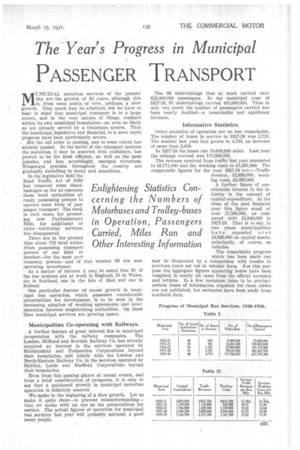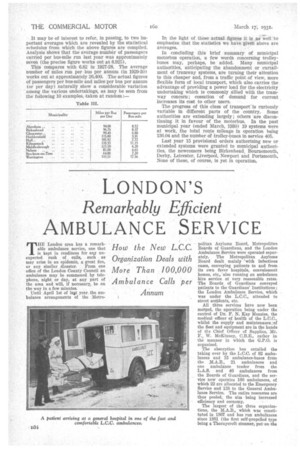The Year's Progress in Municipal
Page 103

Page 104

If you've noticed an error in this article please click here to report it so we can fix it.
PASSENGER TRANSPORT
MUNICIPAL motorbus services of the present day are the growth of 30 years, although this is, from some points of view, perhaps, a slow growth. That much may be admitted, but we have to bear in mind that municipal transport is to a large extent, and in the very nature of things, confined within its own municipal boundaries—an area as likely as not already served by a tramways system. Thus the handicaps, legislative and financial, to a more rapid progress have been particularly severe.
. But the old order is passing, and to some extent has already passed. In the battle of the transport systems the motorbus, it may be asserted with confidence, has proved to be the most efficient, as well as the most popular, and has, accordingly, emerged victorious. Tramways systems throughout the country are gradually dwindling to decay and demolition.
In the legislative field the Road Traffic Act of 1930 has removed some disadvantages so far as concerns those local authorities already possessing powers to operate some form of passenger transport The need. in such cases, for promoting new Parliamentary Bills, for additional or extra territorial services, has disappeared.
There are at the present time about 170 local authorities possessing transport powers of one kind or another—for the most part tramway powers—and of that operating motonbuses. As a matter of interest it may be noted that 81 of the bus systems are at work in England, 10 in Wales, six in Scotland, one in the Isle of Man and one in Ireland. .
One particular feature of recent growth in municipal bus operation, which possesses considerable potentialities for development, is to be seen in the increasing adoption of working agreements and interoperation between neighbouring authorities. On these lines municipal services are growing apace. number 99 are now
Municipalities Co-operating with Railways.
A. further feature of great interest lies in municipal co-operation with the railway companies. The London, Midland and Scottish Railway Co. has already acquired an interest in the services operated by Huddersfield and Todmorden Corporations beyond their boundaries, and jointly with the London and North-Eastern Railway Co. in the services operated by Halifax, Leeds and Sheffield Corporations beyond their boundaries.
Even from this passing glance at recent events, and from a brief consideration of prospects, it is easy to see that a quickened growth in municipal motorbus operation is definitely assured.
We spoke in the beginning of a slow growth. Let us make it quite clear—to prevent misunderstanding— that we spoke with an eye on the potentialities for service. The actual figures of operation for municipal bus ,services last year will probably astonish a good many people.
The 98 undertakings then at work carried over 823,000,000 passengers. In the municipal year of 1927-28,91 undertakings carried 481,000,000. Thus in only two years the number of passengers carried has been nearly doubled—a remarkable and significant increase.
Informative Statistics.
Other statistics of operation are no less remarkable. The number of buses in service in 1927-28 was 2,721. The number last year had grown to 4,733, an increase of more than 2,000.
In 1927-28 the buses ran 70,616,000 miles. Last year the mileage covered was 117,606,000.
The revenue received from traffic last year amounted to £6,771,000 and the working costs to £5,561,000. The comparable figures for the year 1927-28 are :—Traffie revenue, £3,899,000; working costs, 13,036,000.
A. further figure. of considerable interest to the inchAtry is the amount of capital expenditure. At the close of the past financial year this figure stood at over £7,566,000, as compared with £3,940,000 in 1927-28. That is to say, in two years -municipalities have expended over £3,626,000 on capital assets, principally, of course, on vehicles.
The remarkable progress which has been made can best be illustrated by a comparison with results in previous years set out in tabular form. For this purpose the aggregate figures appearing below have been compiled,, in nearly all eases from the official accounts and returns. In a few instances (nine to be precise) certain items of information required for these tables are not published, but estimates have been made from available data. It may be of interest to refer, in passing, to two important averages which are revealed by the statistical schedules from which the above figures are compiled. Analysis shows that the average number of passengers carried per bus-mile run last year was approximately seven (the precise figure works out at 6.925).
This compares with 6.82 in 1927-28. The average number of miles run per bus per annum (in 1929-30) works out at approximately 26,400. The actual figures of passengers per bus-mile and miles per bus per annum (or per day) naturally show a considerable variation among the various undertakings, as may be seen from the following 10 examples, taken at random:— In the light of these actual figures it is as' well c'to emphasize. that the statistics we have given above are averages.
In concluding this brief summary of municipal motorbus operation, a few words concerning trolleybuses may, perhaps, be added. Many municipal authorities, anticipating the abandonment or 'curtailment of tramway systems, are turning their attention to this cheaper and, from a traffic point of view, more flexible form of local transport, which also carries the advantage of providing a power load for the electricity undertaking which is commonly allied with the tramway concern; cessation of demand for current increases its cost to other users.
The progress of this class of transport" s curiously variable in different parts of the country. Some authorities are extending largely ; others are discontinuing it in favour of the motorbus. In the past municipal year (ended March, 1930) 19 systems were at work, the total route mileage in operation being 136.04 and the number of trolley-buses in service 405.
Last year 15 provisional orders authorizing new or extended systems were granted to municipal authorities, the newcomers being Birkenhead. Bournemouth, Derby, Leicester, Liverpool, Newport and Portsmouth. None of these, of course, is yet in operation.
























































































































































































